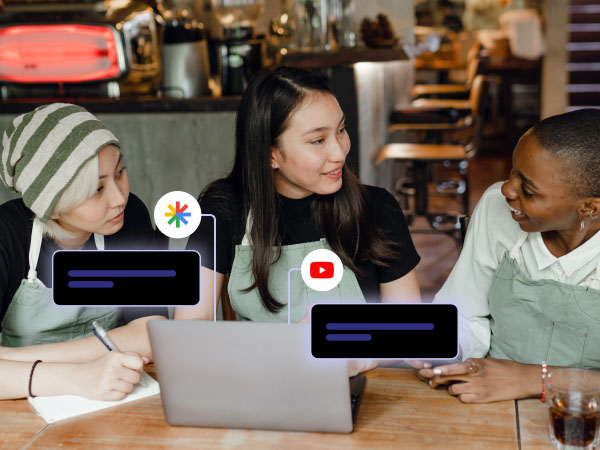
What local marketers need to know about digital marketing’s cookieless future
Share
Schedule a 30-min marketing strategy call with our team
This content was originally published on Localogy, the local marketing association, as a guest post by Philip Bruno.
…
Apple, Google, and Facebook are amidst a seismic shift in user privacy that is forcing the digital advertising industry to re-think two of its foundational pillars: targeting and measurement. The deadlines for businesses to react to these changes are fast approaching (Google, for example, announced in January that cookies will no longer be effective on its Chrome browser by 2022), and local marketers need to be prepared for what lays ahead.
In this blog post, I will review what these user privacy changes are, describe their impacts, and reveal two opportunities for local marketers in this evolving landscape of digital advertising.
The User Privacy Evolution
Changes to Apple IDFA
Every day over 1.4 billion people access the web or an app on an Apple device using Apple’s operating system, iOS. As users consume browser or app-based content on Apple devices, a program runs in the background called IDFA (Identifier for Advertisers). This program sends data back to a third party so, amongst other use cases, marketers can better target audiences and identify ways that people engage with content for measurement optimization purposes.
As an example, if an ad promoting reservations at a Seattle Italian restaurant is served to an Italian food lover using an Apple device in Seattle, and that fan clicks the ad to make a reservation, the IDFA is the digital identifier that was used to stitch behavioral data that ad platforms use to identify that a) the user likes Italian food, so an ad about Italian food should be served to them (targeting), and b) the user who clicked the ad booked a reservation, so attribution can be assigned back to the marketing campaign (measurement).
Apple IDFA was built to enable advertising on mobile devices in a privacy-centric manner. The idea was that users would have control over whether advertisers, apps, and websites had access to their information.
However, in order to control Apple IDFA, users had to do so via their iPhone settings – and most were unaware this identifier even existed. About 20% of all iPhone users had “Limited Ad Tracking” enabled and there were ways that companies would circumvent these limitations. Moreover, companies still made use of IDFA in unintended ways.
In June 2020, Apple announced changes to the rules of how companies can access the iOS IDFA with the release of iOS 14. In an effort to protect user privacy, the default for all iOS users would be such that users would have to expressly opt-in to IDFA sharing.

Experts are estimating that the new status quo for the percentage of Apple users opting-in will jump from 20% to 95%, impacting up to 1.5 billion Apple users worldwide.
The ripple effect of this change is profound.
Google Kills the Cookie
Simultaneously, Google is in the midst of migrating its web browsing service, Chrome, to become cookie-less. Chrome accounts for roughly 40% of the browser market and over 310 million people use Chrome as their primary browser.
Cookies are snippets of information derived about a user from their website activities and browsing history. Historically, advertising platforms have used cookies to build targeted audiences and measure the effectiveness of paid advertising. They also help identify users as they browse the web.
Cookies gave rise to an entire industry of advertising and marketing technologies. To put this in context, in 2019, marketers in the USA spent $11.9 billion on targeted audiences that were built using “third party data.” These audiences, for example, tell ad tools used by local marketers, which individuals like Italian food, and who is more likely to make a reservation at a restaurant after clicking on an ad.
What’s the Impact On Digital Marketing?
t’s clear that the future of digital marketing will have an absolute focus on user privacy. Here are three things you can expect to see in the emerging privacy-first world.
(1) IDFA restrictions mean that opt-in will be required for half of U.S. smartphone users (i.e., iPhone users). Platforms like Facebook will need to secure this opt-in so that advertisers on Facebook can continue to target users and measure success.
(2) Digital media companies with their own logged-in user base, known as “walled gardens,” will continue their advantage in the digital media landscape, building technology to meet user privacy standards while creating unique advantages.
Google announced several proposals including the Federated Learning of Cohorts (FLoC). FLoC allows targeting of groups of people with similar interests into an audience. This approach effectively hides individuals “in the crowd” and uses on-device processing to keep a person’s web history private on the browser. Google claims that FLoC can replace the third-party cookie and deliver results that are 95% comparable when targeting in-market and affinity audiences. To be determined is the effectiveness of advertising through third-party demand side platforms, which may not have full access to FLoC data. Time will tell how Google grants access to this technology outside of its walled garden!
One of the ways Facebook is adjusting to Apple’s IDFA changes is through an initiative called Aggregate Event Measurement. This initiative will limit the number of conversion events that Facebook will optimize towards, with a maximum of eight conversion events per domain (previously, an unlimited amount of conversion events were allowed). Examples of conversion events could be web page visits, registrations, add-to-cart, and purchase. If Facebook advertising is a part of the way that you drive business, we recommend reading Facebook’s resources about the upcoming changes and what is required of marketers.
(3) Remarketing and retargeting programs will be impacted. Be aware that in the short term, retargeting/remarketing campaigns may lose effectiveness because iOS audiences will be smaller, and measurement of iOS users will be limited. It should be noted that all advertising platforms will be impacted by IDFA restrictions equally – Twitter, Pinterest, Snapchat, Amazon Ads, and others will see diminished targeting and measurement capabilities. In the long-term, the concept of retargeting may change. Versus deterministic audiences, remarketing will likely include an intent signal combined with predictive modeling to reach a “likely” group of users. Companies built around remarketing services will have to pivot their platforms to become much more algorithmic, and align with new privacy standards.
What This Means for Local Marketers
The new privacy landscape will increase the level of expertise local marketers need in order to become successful with digital marketing. But with every changing tide, new opportunities can be found. Here are two ways we see the local marketing landscape shifting.
(1) With third-party audiences taking a back seat, first-party data will become increasingly valuable. Businesses with rich amounts of customer data will have an extreme advantage. Franchisors and national marketing teams will be well-positioned to capitalize on this opportunity. This will create a demand for distributed marketing technology that can solve the complexities that the user privacy evolution has created, for example, platforms that specialize in the sharing of digital assets and audiences so local marketers can activate sophisticated programs across channels simply, and without the need for specialized marketing expertise.
(2) Local businesses without the support from national teams or franchisors will need to find such tools elsewhere. This will create a need for tools that already serve small business marketing needs (such as CRM providers, website builders, email marketing tools, and listing management tools), to enable digital advertising capabilities that address the need for first-party audiences through channel partner APIs.
Conclusion
The digital marketing landscape is very much in a state of flux and many of the challenges presented here have yet to be solved. But one thing is certain: the future will be different than anything we have known previously, and it will have a continued focus on user privacy. Ultimately, whether within platforms like Facebook or Google, or on the back-end systems that power businesses, local marketers have the power to get prepared for these changes by adopting best practice recommendations and evolving your approach. Those that do adapt will capitalize on a tremendous opportunity to gain market share and win new customers!
Share
Subscribe to our blog
Don’t miss a beat in the fast-changing local digital marketing landscape — sign up to stay ahead of the curve!






